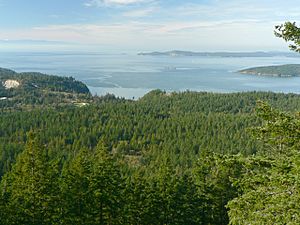Samish Indian Nation facts for kids

View of Fidalgo Island
|
|
| Total population | |
|---|---|
| 2,000 | |
| Regions with significant populations | |
| Languages | |
| Samish, English | |
| Religion | |
| Traditional | |
| Related ethnic groups | |
| Lummi, Saanich, Semiahmoo, Songhees, and Sooke peoples |
The Samish Indian Nation is a Native American group. They are part of the Coast Salish people. The Samish signed an important agreement called the Treaty of Point Elliott in 1855.
Today, the Samish Nation has a special relationship with the United States government. This is called a "government-to-government" relationship. The main office for the Samish Nation is in Anacortes, Washington. This city is on Fidalgo Island, north of Puget Sound.
Some Samish people are also members of the Lummi Nation or the Swinomish Tribe. A Washington state ferry boat, the MV Samish, was named after the Samish Nation in 2015.
Contents
History of the Samish People
The Samish Nation signed the Point Elliott Treaty in 1855. Before this, many Samish people became sick from new diseases. Their population dropped from about 2,000 to only 150 people.
The treaty created several reservations for Native American groups. The Samish were supposed to get one, but many chose to stay on their traditional islands. These islands included Fidalgo, Guemes, and the San Juans.
In 1969, the Samish Nation was accidentally left off a list of federally recognized tribes. This meant they lost some important rights. For example, they were left out of a court decision about fishing rights.
The Samish Nation worked hard to fix this mistake. In 1996, they won back their federal recognition. This allowed them to start getting their land back. They also began working to restore their treaty rights.
Samish Land and Territory
The Samish Nation's traditional lands cover a wide area. This includes west Fidalgo Island, Guemes Island, and Samish Island. It also includes Lopez Island and southeast San Juan Island.
In the 1800s, the Samish were promised a reservation. This promise was not kept for a long time. However, since the 1990s, the Samish Nation has been buying back land.
Today, the Samish Nation owns over 200 acres. About 78 acres are held in trust at Campbell Lake on Fidalgo Island. "Held in trust" means the land is set aside for the tribe.
Other lands owned by the Samish Nation include:
- Fidalgo Bay Resort: This is a place where canoes land during the yearly Canoe Journey.
- Huckleberry Island: The State of Washington gave this island to the Samish. It is still open for public use.
- More land at Campbell Lake.
- Farmland on Thomas Creek.
- A site for new businesses on Highway 20 in Anacortes.
- Samish Nation offices in Anacortes and Summit Park.
- The Samish Longhouse preschool and child care center.
- The Cannery Building near Seafarers Memorial Park.
- Lands and tidelands on Mud Bay on Lopez Island.
Samish Language and Culture
The Samish Nation works with museums and other groups. This helps them get back important items from their ancestors. These items are called "ancestral objects."
Some objects returned include:
- A house post from the last longhouse on Guemes Island.
- A canoe from around 1855.
- Many baskets, hats, mats, and tools used for weaving and fishing.
- A wooden serving dish and water bucket.
While most Samish people speak English, their traditional language is Samish. This language is a dialect of Straits Salish. The Nation has a language preservation program. They have recorded many hours of interviews with people who speak Samish fluently. Kelly Popólxmot Hall teaches the Samish language.
The Samish Nation also hosts Camp Samish every year. They offer regular classes where people can learn traditional crafts. These include making baskets, hats, and other items from cedar.
Important Samish Leaders
Many people have been important to the Samish Nation. Here are a few notable individuals:
Herman “Jinks” Blackinton
Herman “Jinks” Blackinton (1892-1974) was a member of the Samish Tribal Council. This council helps lead the tribe. His grandson, Jeff Morris, later served in the Washington state House of Representatives.
Charles Edwards, Master Carver
Charles Edwards (1866-1948) was a skilled carver and a political leader. He carved famous racing canoes like The Telegraph and Question Mark 2. He also carved a 60-foot pole in 1938 that showed important cultural figures. Charles Edwards represented the Samish Nation in a court case in 1926. His son, Alfred, later became chairman of the Samish Indian Nation.
Margaret Cagey Greene, Chairwoman
Margaret Cagey Greene (1924-2016) was a chairwoman of the Samish Nation. She led the fight to get the Samish Nation's federal recognition back. She was chairwoman from 1971-1974 and again from 1987-1996. She told a reporter in 1992, "Our Samish people have survived... We still want our Indian identity."
Ken Hansen, Longtime Chairman
Ken Hansen (1952-2006) was a longtime chairman of the Samish Indian Nation. He also helped lead the effort to restore the Samish's government-to-government relationship with the United States.
Marco Hatch, Marine Biologist
Marco Hatch is a marine biologist and a professor. He studies the ocean and its living things.

